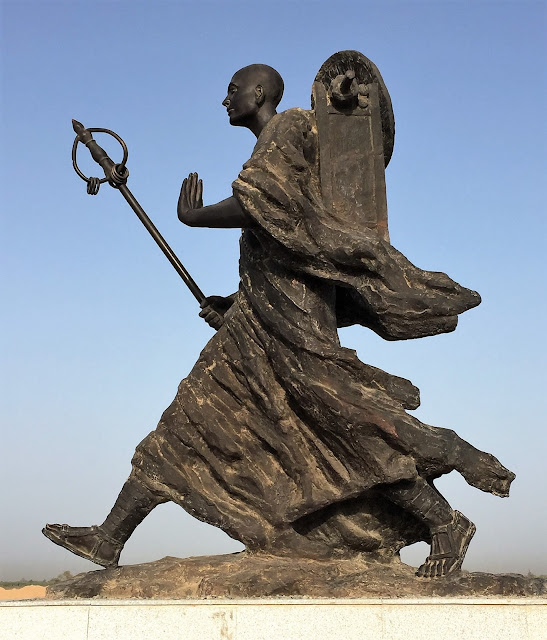Prior to visiting the Taklamakan Desert, I had never heard of it, even though at 130,000 square miles, it is slightly larger than the state of New Mexico and just a little smaller than the country of Germany. The old Silk Road split into a north road and a south road at the desert's edge, circumventing the extreme conditions that include temperatures as low as -15℉ in the winter and 110℉ in the summer. In addition to lack of water, a phenomenon known as "shifting sands," which is when wind-whipped sands cause dramatic landscape changes, further complicates a journey through this wasteland. Almost 85% of the Taklamakan Desert experiences shifting sands, making crossing its vast expanse especially treacherous.
It doesn't look too bad from the bus window:
. . . but the further we go, the drier it gets. I was glad it was October 3rd rather than August 3rd or January 3rd:
Our first stop was the ancient oasis city of Gaochang, located on the threshold of the Taklamakan Desert.
I love his long, energetic stride. The combination of his flowing cloak and his backpack reminds me of wings:
A new visitors center prepares modern travelers for their stay in Gaochang:
I especially appreciate seeing women among the heroes:
From a distance it looks like stone formations, not man-made buildings:
But as we drew closer, we could see these were indeed ruins:
After we roamed through the "Terraced Houses," we made our way to the "Buddhist Temple":
At one time this perfectly round building within a square, which is either the "Preaching House" or a storage area, depending on which source you consult, had a domed roof:
The walls are covered with Arabic writing:
Perhaps this niche was once the backdrop for a large Buddha:
We gathered for a lecture inside the central courtyard:
We all had headsets that allowed us to hear Michael Wilcox's wonderful lectures, even if we were wandering around a little while he spoke:
. . . often unabashedly taken pictures of us:
On our way out we ran into a group of ESL teachers from BYU out on a sightseeing trip. They had a BYU flag on a stick. How random! In a country this big in a site so remote, our two groups converged on the same place at the same time. Amazing.
As we made our way back to our buses, we noticed these oblong cantaloupe-looking fruits for sale. We would later learned that they are hami melon, and that they are very tasty:
A bag of light raisins was a reminder that many of the dried fruits in China come from this region. They aren't necessarily grown here, but the hot, dry weather makes it a perfect place for processing fruit:
On our drive away from Gaochang, we couldn't help but be in awe of the surrounding landscape.
That a city could exist in this region--without any of our modern amenities such as refrigeration--is mind-boggling.
I'd like to know more about these last pictures. It would have been fun to see something being filmed there.




















































Yeah, that was a movie set, but for Chinese movies. I love the statue of Xuanzang. Micheal's talk on him and the Silk Road is, I think, the best talk we've heard him give, partly because the subject is so foreign to us and he pulled all these diverse things together in such a meaningful way.
ReplyDelete